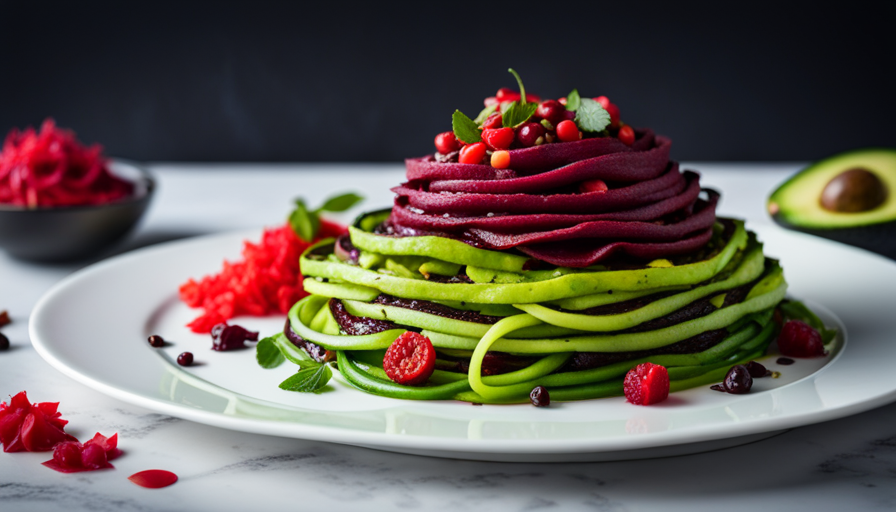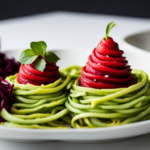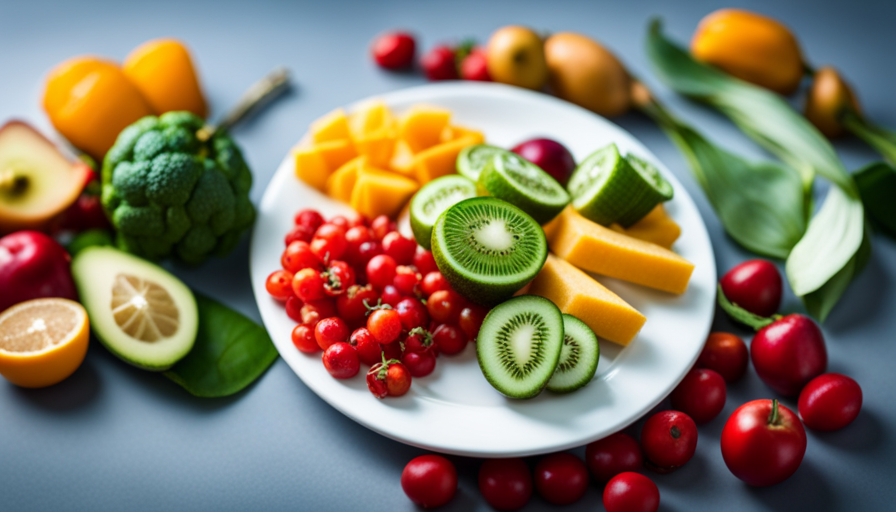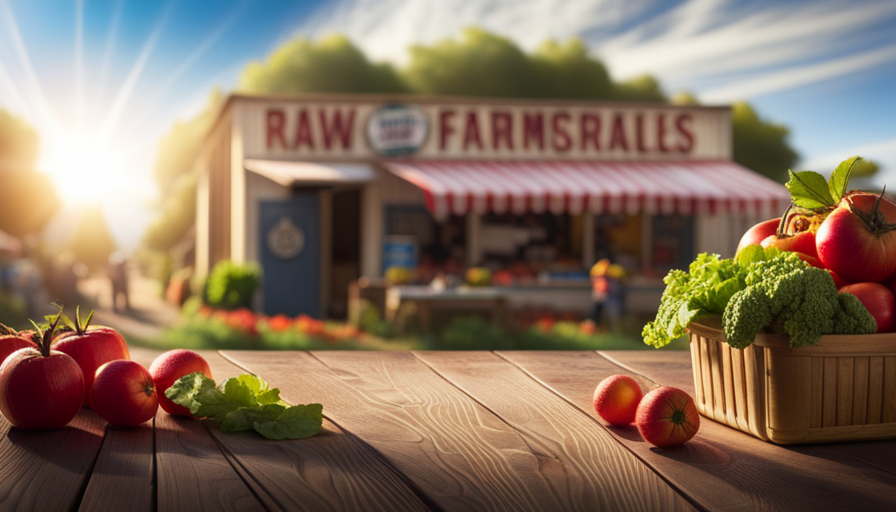Do you ever feel like you’re in a cooking slump, always turning to the same recipes day after day? I know I do. But I’m here to tell you, there’s a vast array of bold and thrilling flavors just waiting to be discovered – and it all begins with raw food cuisine.
Picture this: you’re standing at the edge of a lush, bountiful garden. The air is filled with the intoxicating scent of fresh herbs and ripe fruits. The sun caresses your skin, warming you from the inside out. As you reach out to pluck a juicy tomato, the juice drips down your chin, bursting with a burst of tangy sweetness. This, my friends, is the essence of raw food.
Now, I understand that raw food may not be everyone’s cup of tea. Some people are put off by the idea of eating food in its natural state. But fear not, because I am here to guide you on a journey of culinary discovery.
In this article, we will explore delicious raw recipes that even the most die-hard cooked food enthusiasts will love. So let’s embark on this raw food revolution together and embrace the abundance of flavors and nutrients that await us.
Key Takeaways
- Raw food cuisine offers a variety of vibrant flavors and textures that can help break out of a culinary rut.
- Incorporating raw foods into your diet can enhance nutrient absorption, increase energy levels, and strengthen the immune system.
- Raw salads, such as Colorful Vegetable Medley, Zesty Citrus Salad, and Nutty Kale Salad, are fresh, flavorful, and packed with nutrients.
- Raw soups and smoothies, like creamy avocado soup and various fruit blends, are easy to make, delicious, and nourishing options for those who don’t typically enjoy raw food.
Introduction to Raw Food Cuisine
Get ready to discover a whole new world of vibrant flavors and nourishing ingredients with the exciting realm of raw food cuisine! Raw food techniques and preparation methods have completely transformed my perspective on healthy eating.
At first, I was skeptical about the idea of consuming raw food, thinking it would be bland and boring. However, I couldn’t have been more wrong! Raw food cuisine is a culinary adventure that showcases the natural flavors and textures of fruits, vegetables, nuts, and seeds in the most delightful way.
One of the key aspects of raw food techniques is the use of dehydrators, which allow you to create crispy snacks and bread-like treats without subjecting them to high heat. This preserves the enzymes and nutrients in the food, making it even more beneficial for our bodies. Another popular method is blending, which helps create creamy soups, smoothies, and sauces with a rich and velvety texture.
The great thing about raw food preparation methods is that they require minimal cooking time, allowing you to enjoy the freshness and vibrant colors of the ingredients. From colorful salads bursting with flavors to zucchini noodles topped with a creamy avocado sauce, raw food cuisine offers endless possibilities to tantalize your taste buds.
So, now that you have a taste of the exciting world of raw food cuisine, let’s move on to the benefits of incorporating raw foods into your diet.
Benefits of Incorporating Raw Foods into Your Diet
Imagine feeling more energized, improving your digestion, and boosting your immune system simply by incorporating more fresh, nutrient-rich ingredients into your meals. That’s the power of incorporating raw foods into your diet.
Raw foods are packed with essential vitamins, minerals, and enzymes that can have a profound impact on your overall health. Here are three key health benefits of incorporating raw foods into your diet:
-
Enhanced Nutrient Absorption: Raw foods retain their natural enzymes, which aid in the digestion and absorption of nutrients. This means that when you eat raw foods, your body can extract more vitamins, minerals, and antioxidants, giving you a nutritional boost.
-
Increased Energy Levels: Raw foods are rich in natural sugars and fibers that provide sustained energy throughout the day. Unlike processed foods, which often lead to energy crashes, raw foods keep you energized and focused.
-
Strengthened Immune System: Raw foods are brimming with antioxidants and phytochemicals that help fight off harmful free radicals and strengthen your immune system. By incorporating more raw foods into your diet, you can reduce the risk of chronic diseases and illnesses.
By now, you’re probably eager to try some fresh and flavorful raw salads.
Fresh and Flavorful Raw Salads
I absolutely love incorporating fresh and flavorful raw salads into my diet. One of my favorite salads is the Colorful Vegetable Medley, which is bursting with vibrant colors and textures. It combines crisp lettuce, juicy tomatoes, crunchy bell peppers, and tangy onions for a truly satisfying salad experience.
Another delicious option is the Zesty Citrus Salad, which combines the refreshing flavors of citrus fruits like oranges and grapefruits with a tangy vinaigrette dressing.
Lastly, the Nutty Kale Salad is a personal favorite of mine, with its combination of earthy kale, crunchy nuts, and creamy avocado.
These raw salads not only provide a burst of flavors but also pack a nutritional punch, making them a perfect addition to any healthy eating plan.
Colorful Vegetable Medley
Mix together a vibrant array of colorful vegetables to create a visually stunning medley that’ll delight your taste buds.
This colorful vegetable stir-fry is the perfect way to incorporate raw food into your diet without sacrificing flavor. I love the combination of crisp bell peppers, juicy cherry tomatoes, and crunchy carrots. The flavors are enhanced by a tangy dressing made with fresh lemon juice, olive oil, and a hint of garlic.
To add a bit of depth to the dish, I like to include some roasted root vegetables, like sweet potatoes and beets. The sweetness of the roasted veggies complements the freshness of the raw vegetables beautifully.
This colorful vegetable medley is a refreshing and satisfying option for those who aren’t fans of raw food.
Now, let’s move on to the next section about the zesty citrus salad.
Zesty Citrus Salad
With a burst of vibrant citrus flavors, this zesty salad will awaken your taste buds and add a refreshing twist to your meal. The combination of tangy oranges, juicy grapefruits, and zesty lemons creates a symphony of flavors that dance on your tongue.
The citrus-infused dressings, made with a blend of lemon juice, orange zest, and a hint of honey, perfectly complement the crispness of the greens. The unique fruit combinations, such as slices of sweet mango and tart pomegranate seeds, add a delightful sweetness and texture to every bite.
This zesty citrus salad is not your ordinary salad; it is a tantalizing explosion of flavors that will leave you craving for more. As you indulge in the refreshing citrus goodness, you’ll be ready to explore the next section, where the nutty kale salad awaits.
Nutty Kale Salad
Get ready to tantalize your taste buds with the nutty kale salad, a delicious and healthy option that’ll have you coming back for seconds.
Did you know that kale is packed with vitamins and minerals, making it a nutrient powerhouse that can help boost your immune system and support overall well-being?
Here are three reasons why you should incorporate kale into your diet:
-
Kale smoothie recipes: Kale’s a fantastic addition to any smoothie. Its earthy flavor adds depth and richness, while its high fiber content keeps you feeling full and satisfied.
-
Nut-free raw snacks: If you’re looking for a healthy snack option that doesn’t contain nuts, kale chips are a great choice. They’re crunchy, flavorful, and packed with nutrients, making them the perfect guilt-free snack.
-
Immune-boosting properties: Kale’s rich in vitamin C, which helps strengthen your immune system. By including kale in your diet, you’re giving your body the tools it needs to fight off illness and stay healthy.
Now, let’s move on to the next section about delicious raw soups and smoothies.
Delicious Raw Soups and Smoothies
Indulge in the creamy goodness of raw soups and smoothies that will leave your taste buds begging for more. When it comes to raw food, many people think of bland and boring salads. But these delicious raw soups and refreshing fruit smoothies are here to change your mind. They are packed with flavor and nutrients, making them the perfect addition to your raw food repertoire.
In my opinion, raw soups are a game-changer. They are incredibly easy to make and require minimal ingredients. One of my favorites is the creamy avocado soup. It’s made with ripe avocados, fresh herbs, and a splash of lime juice. The result is a velvety smooth soup that is both satisfying and nourishing.
When it comes to smoothies, the options are endless. From tropical fruit blends to green detox smoothies, there is something for everyone. My go-to smoothie is a combination of ripe bananas, juicy strawberries, and a handful of spinach. It’s a great way to sneak in some greens without even noticing.
| Incorporate a 3 column and 5 row table in markdown format: | Recipe | Ingredients | Instructions |
|---|---|---|---|
| Creamy Avocado Soup | Ripe avocados, fresh herbs, lime juice | Blend all ingredients until smooth | |
| Tropical Fruit Smoothie | Pineapple, mango, coconut water | Blend all ingredients until creamy | |
| Green Detox Smoothie | Spinach, cucumber, kiwi, coconut water | Blend all ingredients until well combined | |
| Berry Blast Smoothie | Mixed berries, almond milk, honey | Blend all ingredients until smooth | |
| Creamy Cashew Soup | Cashews, vegetable broth, garlic | Blend all ingredients until creamy |
These raw soups and smoothies are not only delicious, but they also provide a burst of energy and nourishment. They are a great way to incorporate more raw food into your diet. So, get ready to slurp up these creamy concoctions and get excited for the next section on raw pasta and noodle dishes.
Raw Pasta and Noodle Dishes
I have to admit, when I first heard about raw food, I was skeptical. I mean, who wants to eat a cold, uncooked meal? But after trying some delicious raw soups and smoothies, I was pleasantly surprised. They were bursting with flavor and packed with nutrients.
So, I decided to explore more raw recipes that could change my mind about raw food. And that’s when I discovered raw pasta and noodle dishes.
Raw zucchini noodles recipes have become my new obsession. They’re incredibly easy to make and surprisingly satisfying. I simply spiralize a fresh zucchini, toss it with some homemade raw sauce, and voila! I have a healthy and delicious pasta alternative. The best part is that raw pasta retains all the nutrients and enzymes that are often lost during the cooking process.
Not only are raw pasta dishes a great way to incorporate more vegetables into your diet, but they also have numerous health benefits. They’re low in calories, high in fiber, and can aid in weight loss. Plus, the raw ingredients provide a natural energy boost and promote better digestion.
Now that I’ve discovered the wonders of raw pasta, I can’t wait to share with you some delectable raw desserts. Trust me, you won’t even miss the traditional baked treats.
Delectable Raw Desserts
Satisfy your sweet tooth with these mouthwatering desserts that’ll make your taste buds dance with joy. When it comes to raw desserts, there are two absolute must-try treats: delicious raw cheesecakes and raw chocolate truffles.
First up, let’s talk about raw cheesecakes. These creamy delights are made with a base of nuts and dates, giving them a rich and buttery texture that perfectly mimics traditional cheesecake. The best part is that they’re completely dairy-free and packed with nutrients. Whether you prefer classic flavors like strawberry or indulgent combinations like chocolate and caramel, raw cheesecakes are sure to impress.
If chocolate is your weakness, then raw chocolate truffles are a dream come true. Made with raw cacao powder, these bite-sized treats are intensely chocolatey and velvety smooth. The best part is that they’re guilt-free and full of antioxidants. From simple flavors like dark chocolate to more adventurous combinations like mint or orange, raw chocolate truffles are a decadent way to satisfy your cravings.
Now, let’s move on to the next section about creative raw snacks and appetizers. But before we do, get ready to tantalize your taste buds with these delectable raw desserts.
Creative Raw Snacks and Appetizers
I absolutely love snacking, especially when it involves something crunchy and flavorful. One of my go-to raw snacks is homemade Crunchy Kale Chips. They’re so addictive with their crispy texture and savory seasoning.
Another favorite of mine is Fresh Spring Rolls with Peanut Dipping Sauce. The combination of the fresh veggies, chewy rice paper, and creamy peanut sauce is just mouthwatering.
And when I’m in the mood for something spicy, I whip up a batch of Spicy Salsa with Raw Veggie Dippers. The salsa is packed with heat and pairs perfectly with the crunchy raw vegetables.
These creative raw snacks and appetizers aren’t just healthy but also incredibly delicious.
Crunchy Kale Chips
Transforming kale into crispy chips offers a delightful alternative for those seeking to appreciate the unique textures and flavors of raw food. Crispy kale snacks are the ultimate guilt-free treat that satisfies both your cravings and your health goals.
With just a handful of ingredients, you can create a flavorful snack that’s packed with nutrients. Simply toss fresh kale leaves with a drizzle of olive oil, sprinkle some sea salt and your favorite spices, and bake until they turn perfectly crispy. The result is a crunchy and addictive snack that’s far more satisfying than any bag of potato chips.
But be warned, once you start munching on these alternative kale recipes, you won’t be able to stop.
Now, let’s move on to another amazing raw appetizer: fresh spring rolls with peanut dipping sauce.
Fresh Spring Rolls with Peanut Dipping Sauce
Indulge in the vibrant flavors of fresh spring rolls, where crispy vegetables and tender rice noodles are delicately wrapped in translucent rice paper, creating a colorful bouquet of flavors that burst in your mouth like a fireworks display.
Fresh spring rolls are a versatile dish, allowing for endless variations to suit your taste. You can fill them with a variety of fresh ingredients such as avocado, mango, cucumber, or even tofu for a vegetarian option. The possibilities are endless!
To elevate the flavors even further, try experimenting with alternative dipping sauces. While the classic peanut dipping sauce is always a crowd-pleaser, you can also try a tangy ginger soy sauce or a spicy sriracha mayo for a kick of heat. The dipping sauce is the perfect complement to the fresh and crunchy spring rolls, adding an extra layer of flavor to each bite.
Now, let’s move on to the next section about spicy salsa with raw veggie dippers, where we’ll explore another delicious and healthy raw recipe.
Spicy Salsa with Raw Veggie Dippers
Immerse yourself in the bold flavors of a zesty salsa, accompanied by a vibrant array of fresh vegetables, creating a tantalizing combination that’ll awaken your taste buds.
This spicy salsa is a burst of fiery goodness, perfect for those who love a bit of heat in their meals. Here are three variations of this mouthwatering dip that’ll leave you craving for more:
-
Classic Jalapeno Salsa: Made with fresh tomatoes, jalapenos, onions, and cilantro, this traditional salsa packs a punch with its spicy kick.
-
Mango Habanero Salsa: For a tropical twist, this variation combines juicy mangoes, fiery habanero peppers, lime juice, and a hint of sweetness for a perfect balance of flavors.
-
Avocado Salsa Verde: Creamy avocados, tangy tomatillos, jalapenos, and garlic come together in this smooth and tangy salsa that adds a touch of richness to your raw veggie dippers.
Looking for alternative raw dip options? Check out the next section for tips on making raw food more palatable.
Tips for Making Raw Food More Palatable
To make raw food more palatable, I can’t stress enough the importance of adding spices and seasonings. They’re the key to transforming bland raw vegetables into a burst of flavor and creating a truly enjoyable eating experience.
When it comes to making raw food more appealing, it’s all about getting creative with your seasonings. I love to experiment with different combinations like garlic, cumin, paprika, and chili powder for a Mexican twist, or turmeric, ginger, and curry powder for an Asian-inspired flavor. Don’t be afraid to play around and find what works best for you!
Incorporating raw food into everyday meals doesn’t have to be a daunting task. Start by adding raw veggies to your favorite dishes. I love adding a handful of spinach or kale to my morning smoothie, or tossing some shredded carrots and cabbage into a stir-fry.
Another great way to make raw food more appealing is by marinating it. I find that marinating raw vegetables in a flavorful dressing or sauce helps soften their texture and infuse them with delicious flavors.
Transitioning into the next section about raw food substitutions for cooked meals, I’ve found that raw food doesn’t have to be a replacement for cooked food. It can be a delicious addition to your meals, bringing freshness and vibrancy to your plate.
Raw Food Substitutions for Cooked Meals
I absolutely love finding raw food substitutions for cooked meals. One of my favorites is using raw cauliflower rice instead of regular rice. It has a similar texture and can be seasoned to taste just like regular rice, but it’s much lighter and more refreshing.
Another great substitution is using raw zucchini noodles instead of pasta. They have a similar shape and can be spiralized to create the perfect noodle texture, but they’re packed with nutrients and have a fresh, crisp taste.
Lastly, I can’t get enough of raw nut cheeses as a replacement for dairy cheeses. They’re creamy, flavorful, and can be made with a variety of nuts to suit different tastes. Plus, they’re packed with healthy fats and protein.
These raw food substitutions have completely transformed the way I enjoy my favorite cooked meals and have made them even more delicious and nutritious.
Raw Cauliflower Rice for Regular Rice
Transform your regular rice into a healthier, low-carb alternative with this delicious recipe for raw cauliflower rice! I used to be skeptical about raw food, but this cauliflower rice has completely changed my mind. It’s light, fluffy, and surprisingly satisfying.
Plus, it’s packed with nutrients that you won’t find in traditional rice. As someone who loves experimenting with alternative grains, this raw cauliflower rice is a game-changer. Not only can you use it as a base for stir-fries and curries, but you can also get creative and make cauliflower pizza crust or even sushi rolls. The possibilities are endless!
And if you’re like me and love pasta, don’t worry, I’ve got you covered. In the next section, I’ll show you how to make raw zucchini noodles for a pasta dish that’ll blow your mind.
Raw Zucchini Noodles for Pasta
Get ready to take your pasta game to a whole new level with these mind-blowing zucchini noodles that will have you saying ‘goodbye’ to traditional pasta! Raw zucchini noodle alternatives are a game-changer for those who want a healthy and delicious alternative to regular pasta. With the right cooking techniques, zucchini noodles can mimic the texture and taste of traditional pasta, making them a perfect substitute for those who don’t like raw food.
To make these zucchini noodles, you’ll need a spiralizer or a julienne peeler to create thin, noodle-like strands. Once you have your zucchini noodles ready, you can sauté them lightly in olive oil or simply enjoy them raw with your favorite sauce or toppings. The possibilities are endless when it comes to creating flavorful dishes with these raw zucchini noodles.
Now, let’s transition into the next section about ‘raw nut cheeses for dairy cheeses’ and discover another amazing alternative for those who are looking for a non-dairy option without sacrificing taste.
Raw Nut Cheeses for Dairy Cheeses
I have to admit, I was skeptical when I first heard about raw nut cheeses as dairy alternatives. I mean, how could a cheese made from nuts possibly compare to the creamy goodness of traditional dairy cheeses?
But let me tell you, I was pleasantly surprised. Raw nut cheeses are a revelation. They have this rich, tangy flavor that is incredibly satisfying. And the texture? Creamy, smooth, and oh so luxurious. It’s like a little slice of heaven on your plate.
Plus, they’re packed with nutrients and natural goodness. Who needs dairy when you’ve got these delicious raw nut cheeses? So go ahead, embrace the raw food revolution and give them a try. You won’t be disappointed!
Transition: Now that we’ve explored some amazing raw recipes, let’s move on to the conclusion: embracing the raw food revolution.
Conclusion: Embrace the Raw Food Revolution
To fully appreciate the raw food revolution, it’s time to wholeheartedly embrace the incredible benefits it offers. Embracing new dietary trends can be intimidating, especially when it comes to raw food. However, once you open yourself up to this lifestyle, you’ll be amazed at the positive impact it can have on your health and well-being.
Here are five reasons why embracing the raw food revolution is worth it:
-
Increased Energy: Raw food is packed with vitamins, minerals, and enzymes that nourish your body and provide long-lasting energy throughout the day.
-
Improved Digestion: Raw food is easier for your body to digest, leading to fewer digestive issues such as bloating and constipation.
-
Enhanced Immunity: Raw food is rich in antioxidants and nutrients that strengthen your immune system, helping you fight off illnesses and infections.
-
Weight Management: Raw food is naturally low in calories and high in fiber, making it an excellent choice for those looking to maintain a healthy weight.
-
Radiant Skin: Raw food is hydrating and contains essential nutrients that promote healthy, glowing skin.
By embracing the raw food revolution, you’ll not only experience these incredible health benefits but also discover a whole new world of delicious and creative recipes that’ll make you fall in love with raw food. It’s time to take a leap of faith and join the raw food movement for a healthier, happier you.
Frequently Asked Questions
How can I make raw food taste more like cooked food?
Looking for ways to make raw food taste more appealing? Let me share some creative ideas to incorporate raw food into your meals that will definitely satisfy your taste buds!
One simple trick is marinating raw veggies in flavorful dressings or sauces to enhance their taste. Also, try adding spices and herbs to give a burst of flavor.
Another option is to blend raw fruits and vegetables into smoothies or juices for a refreshing and delicious twist. Trust me, these techniques will make you fall in love with raw food!
Are there any health risks associated with consuming raw food?
There can be some misconceptions about the health risks of consuming raw food, but in my opinion, when done properly, it can offer numerous benefits.
While there’s a small risk of foodborne illnesses, practicing safe food handling and choosing high-quality ingredients can minimize this.
Raw food is rich in nutrients, enzymes, and antioxidants that can boost our immune system, improve digestion, and promote overall health.
Incorporating raw food into a balanced diet can be a great way to enhance our well-being.
Can I still get all the necessary nutrients from a raw food diet?
Transitioning to a raw food diet is like diving into a vibrant ocean of nutrients. Despite the raw food myths, I’ve found that it’s possible to get all the necessary nutrients. Fresh fruits and vegetables burst with life, providing an array of vitamins, minerals, and antioxidants. Plus, raw foods retain their natural enzymes, aiding digestion and boosting energy levels.
So, if you’re ready to embark on a nutrient-rich journey, give raw food a chance and experience the transformative power of nature’s bounty.
Are there any specific kitchen tools or equipment needed for preparing raw food?
You don’t need any fancy tools or equipment to prepare raw food. Basic kitchen essentials like a good knife, cutting board, blender, and food processor will do the job. However, investing in a dehydrator can greatly expand your options for creating flavorful raw dishes. It helps to remove moisture from fruits, vegetables, and nuts, resulting in a crunchy and delicious texture.
So, while not essential, a dehydrator can take your raw food preparation to the next level.
Can I still eat out at restaurants while following a raw food diet?
Eating out options while following a raw food diet can be challenging, but with some creativity and flexibility, it’s possible. Many restaurants offer salads, which can easily be modified to fit a raw food diet. You can request raw vegetables and dressing on the side. Additionally, you can ask for raw food substitutions like zucchini noodles instead of pasta or lettuce wraps instead of bread. These options, although limited, can still satisfy your cravings and keep you on track with your raw food lifestyle.
Are There Raw Food Recipes That Can Appeal to Those Not Fond of Raw Food?
Yes, there are raw food recipes that can appeal to those not fond of raw food. By incorporating fresh and flavorful ingredients, raw food dining benefits can be enjoyed even by skeptics. Dishes like zucchini noodles with pesto or raw taco salad can impress even the most hesitant eaters.
Conclusion
After delving into the world of raw food cuisine, I’m convinced that incorporating raw foods into your diet isn’t only beneficial but also incredibly delicious. From fresh and flavorful salads bursting with vibrant colors and flavors, to creamy soups and smoothies that leave you feeling nourished and refreshed, the possibilities are endless.
And let’s not forget about the raw pasta and noodle dishes that are surprisingly satisfying and oh-so-creative. With a bit of creativity and some handy tips, you can easily make raw food more palatable and enjoyable. So why not join the raw food revolution and embrace the abundant health and flavor it brings?
It’s like taking a bite of sunshine and feeling your taste buds dance with joy.

















